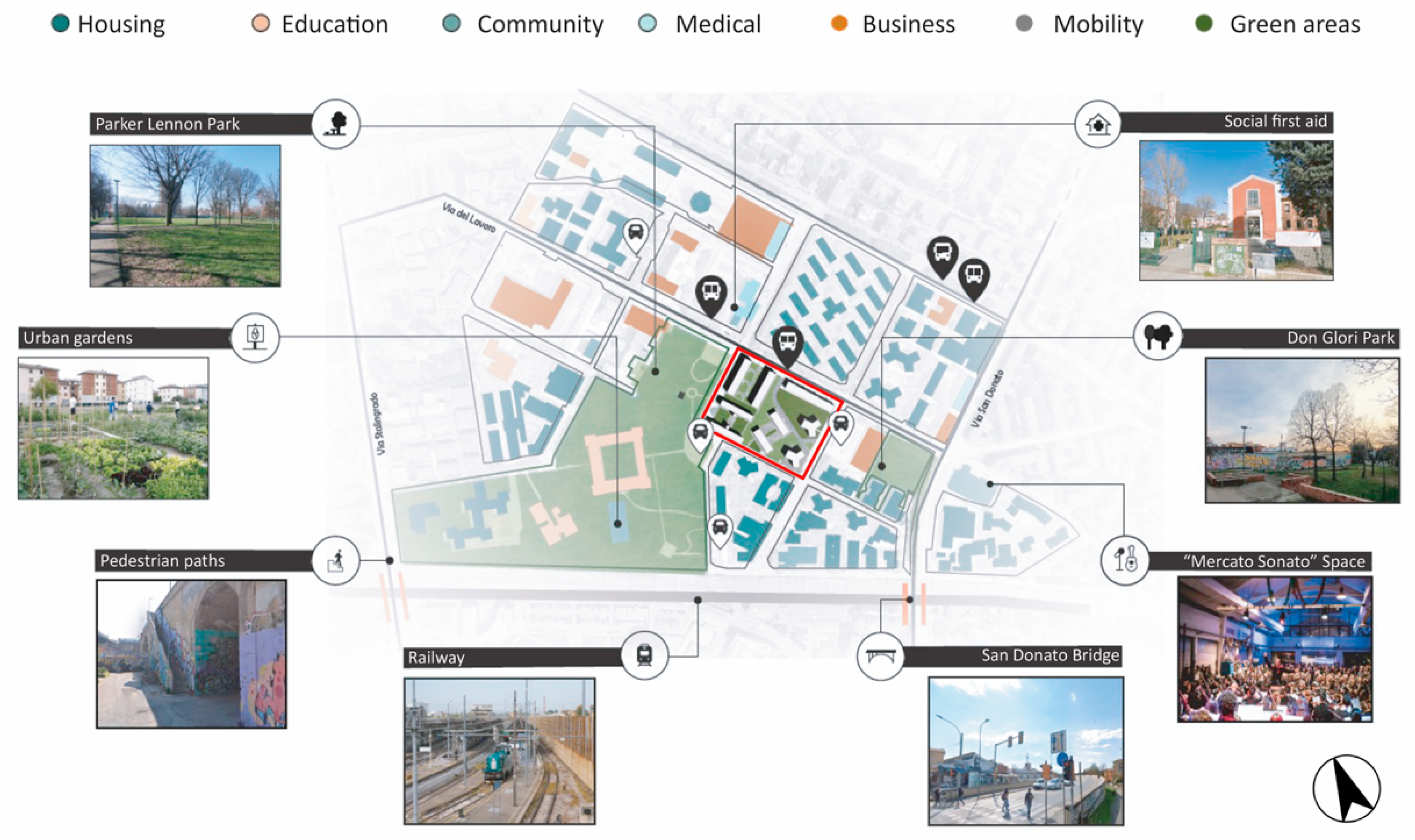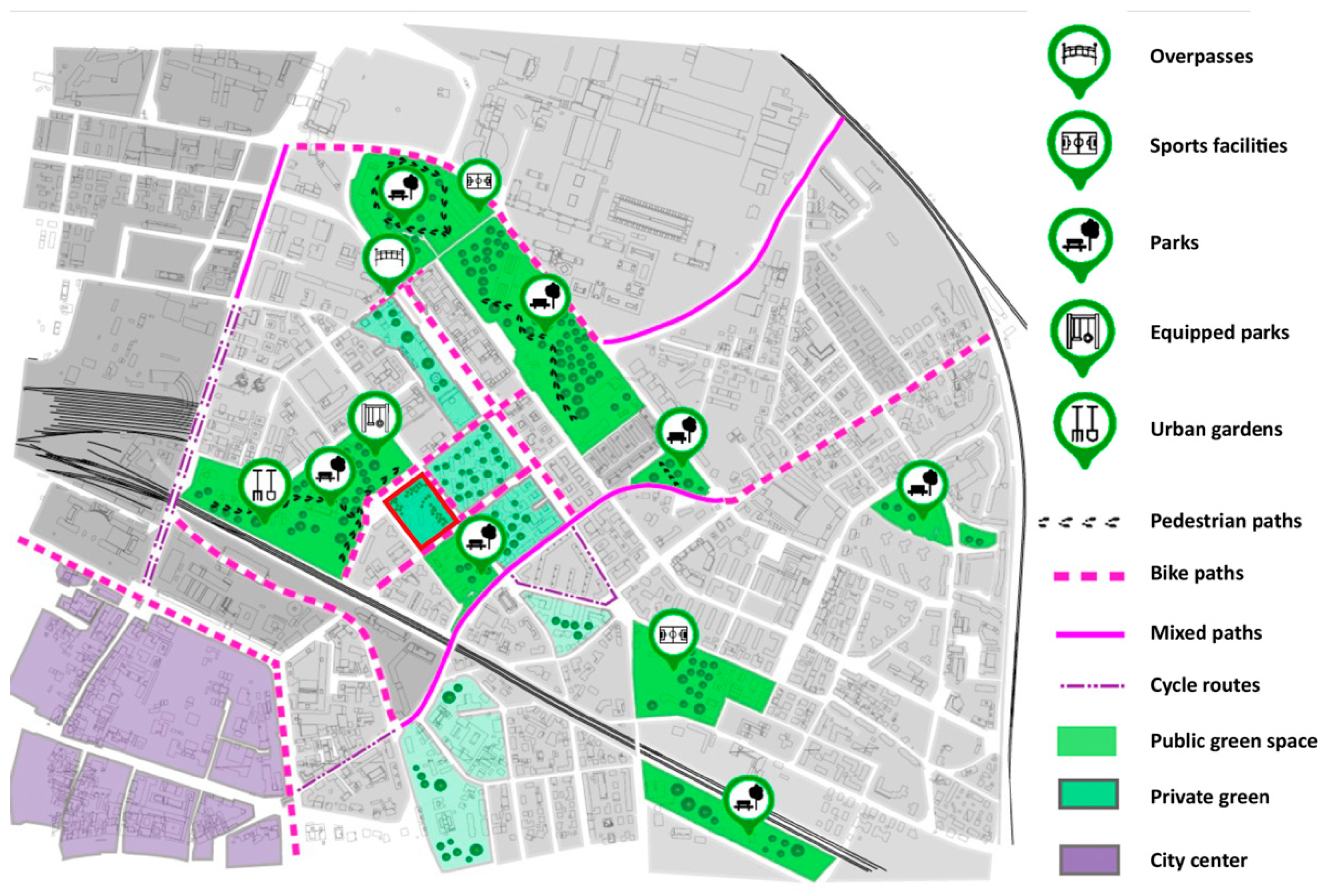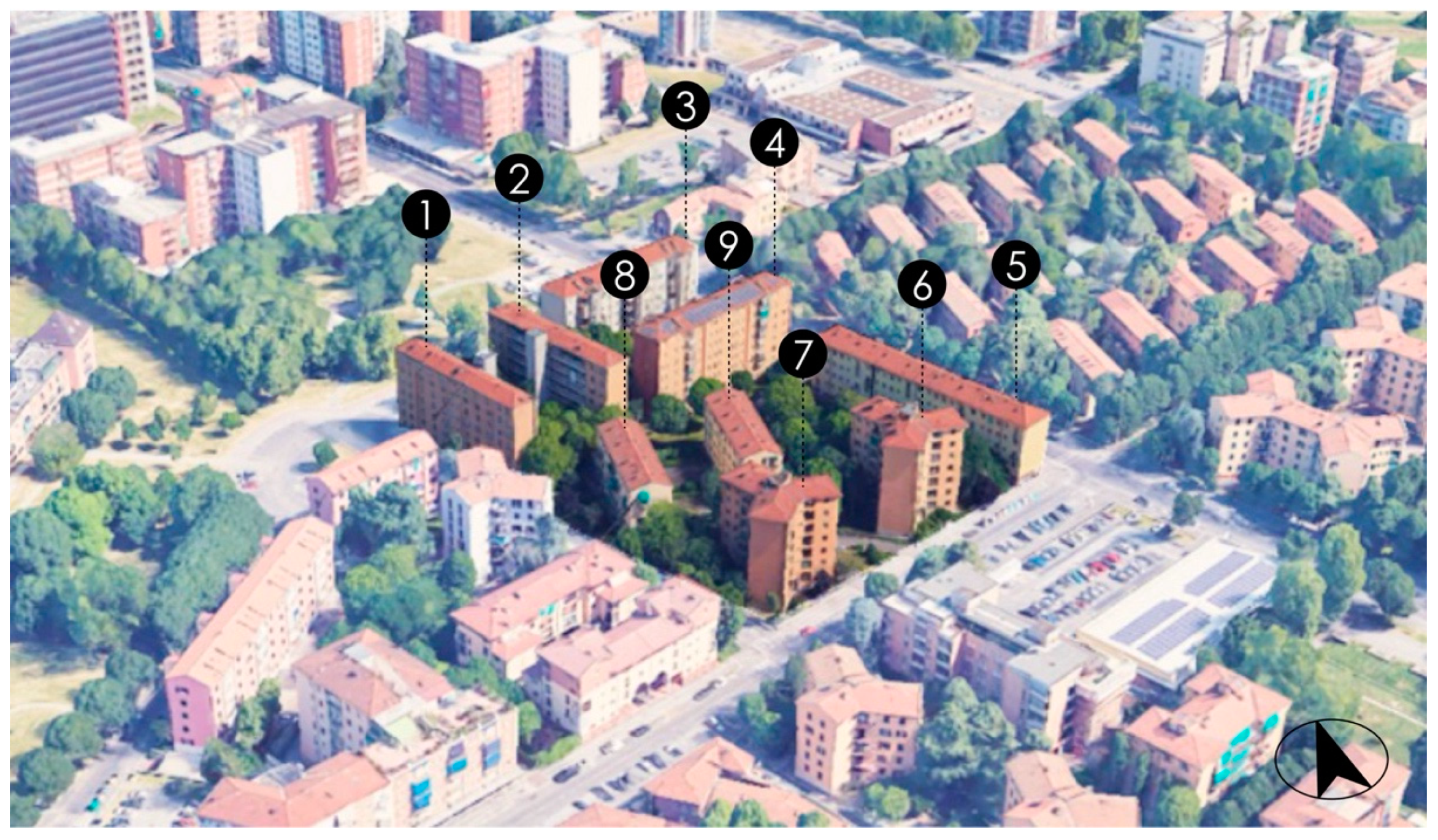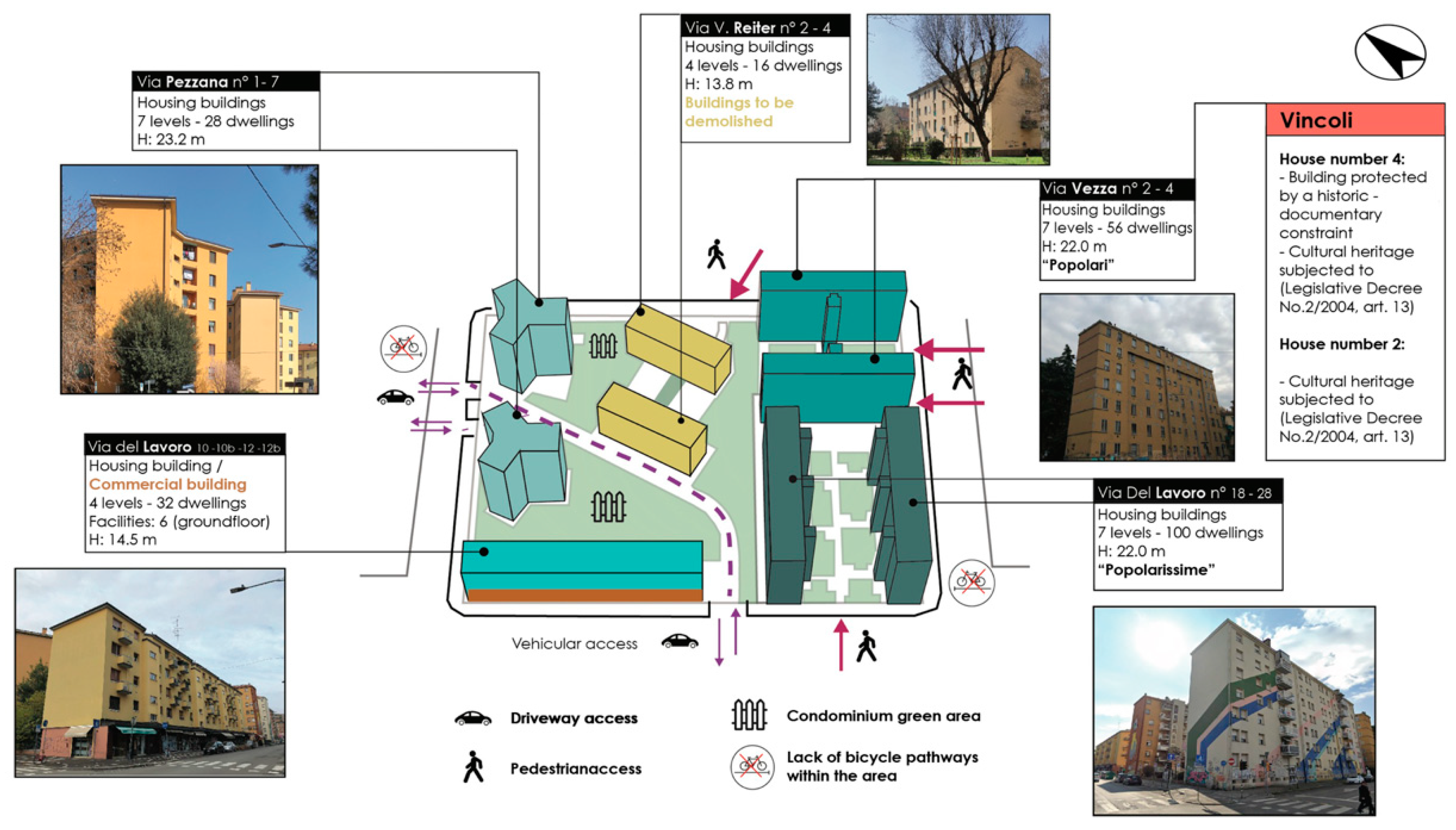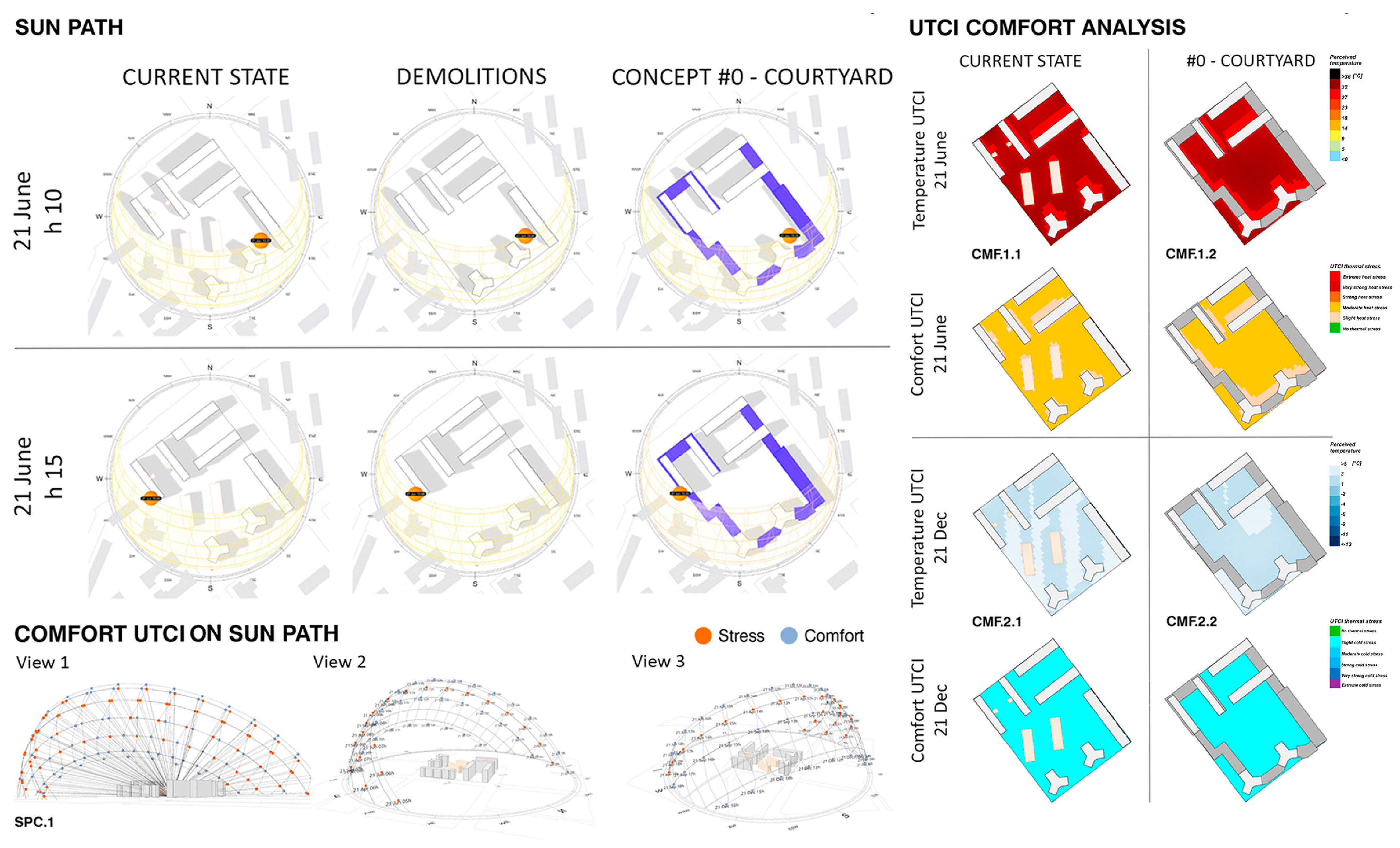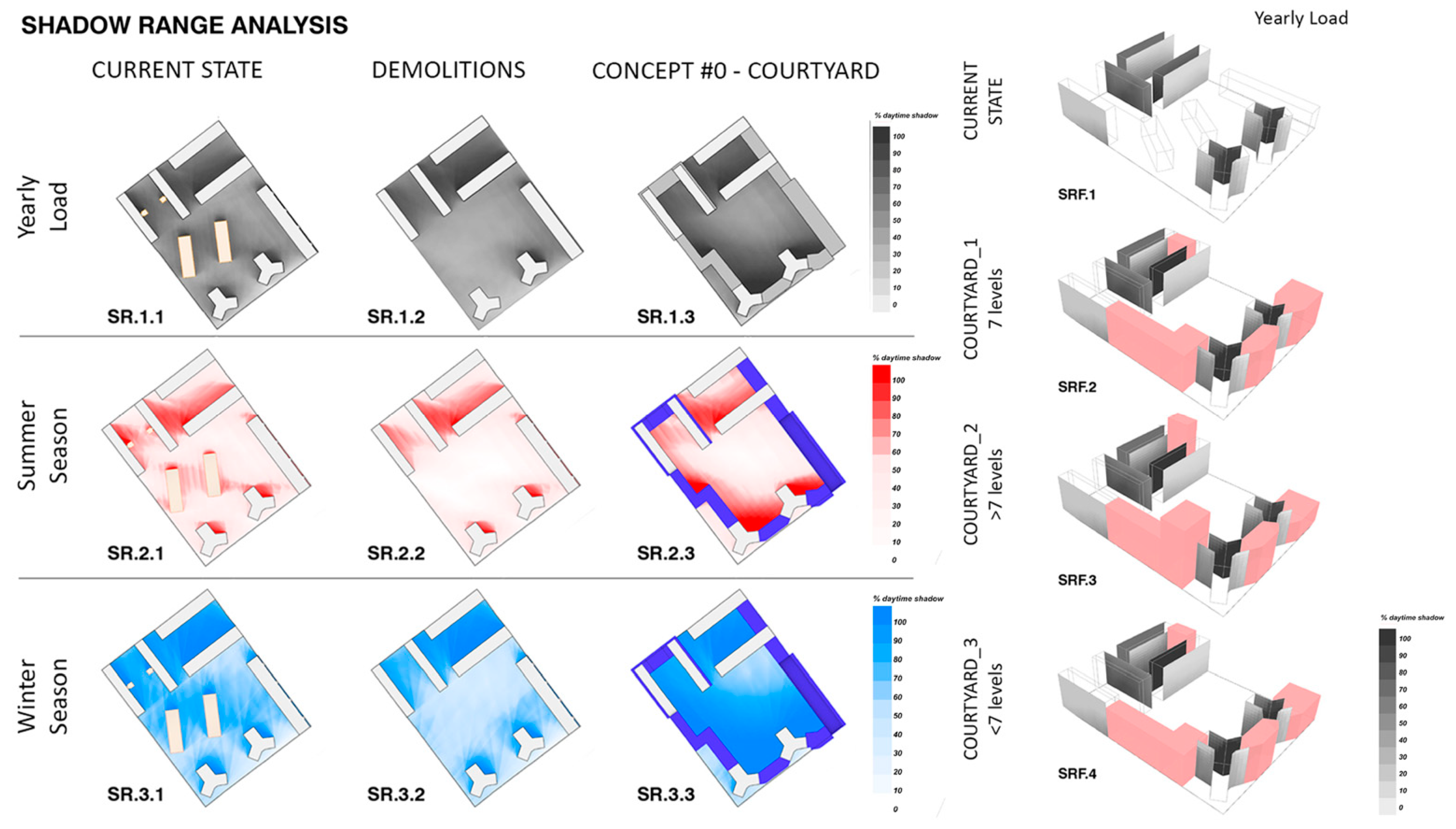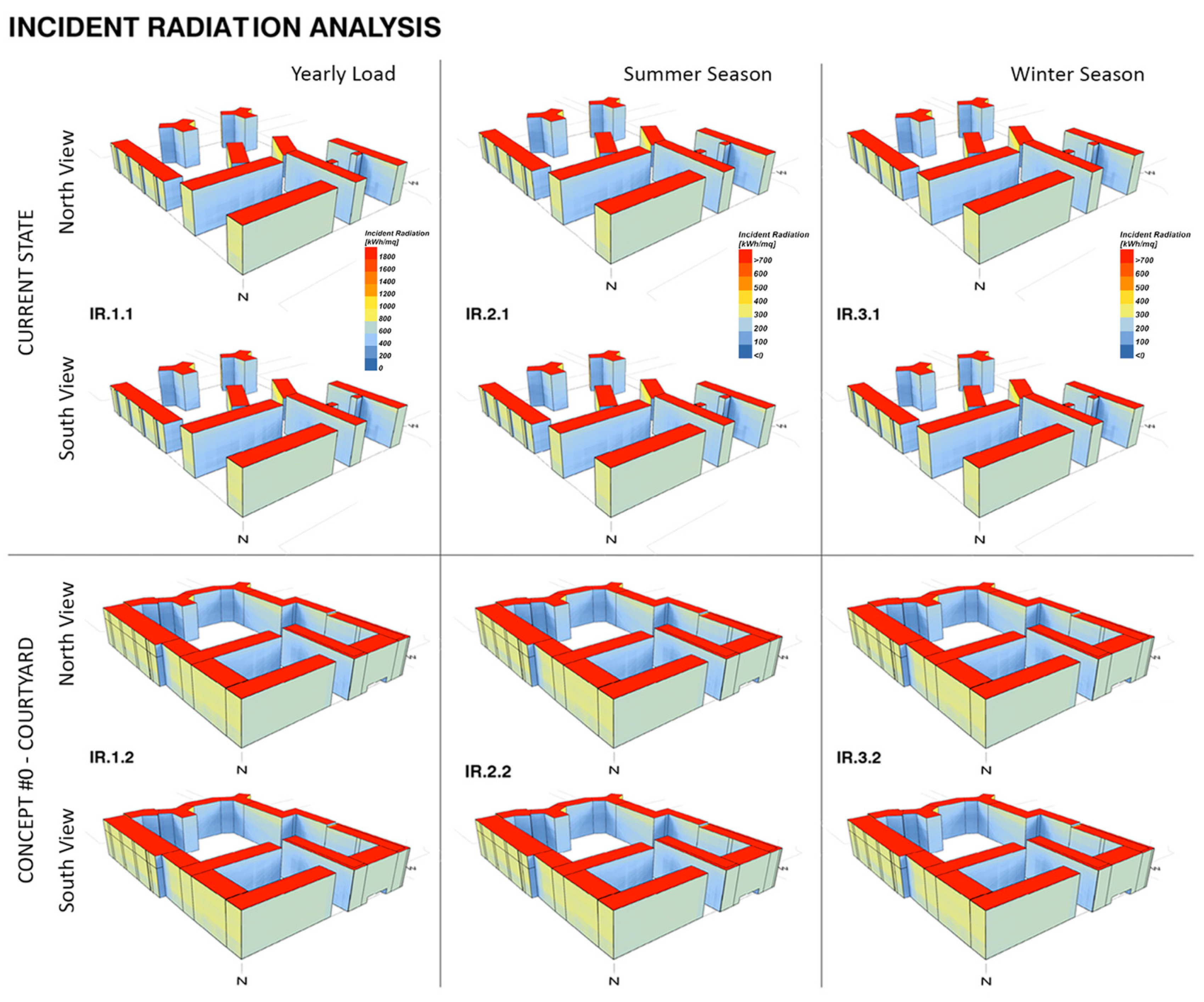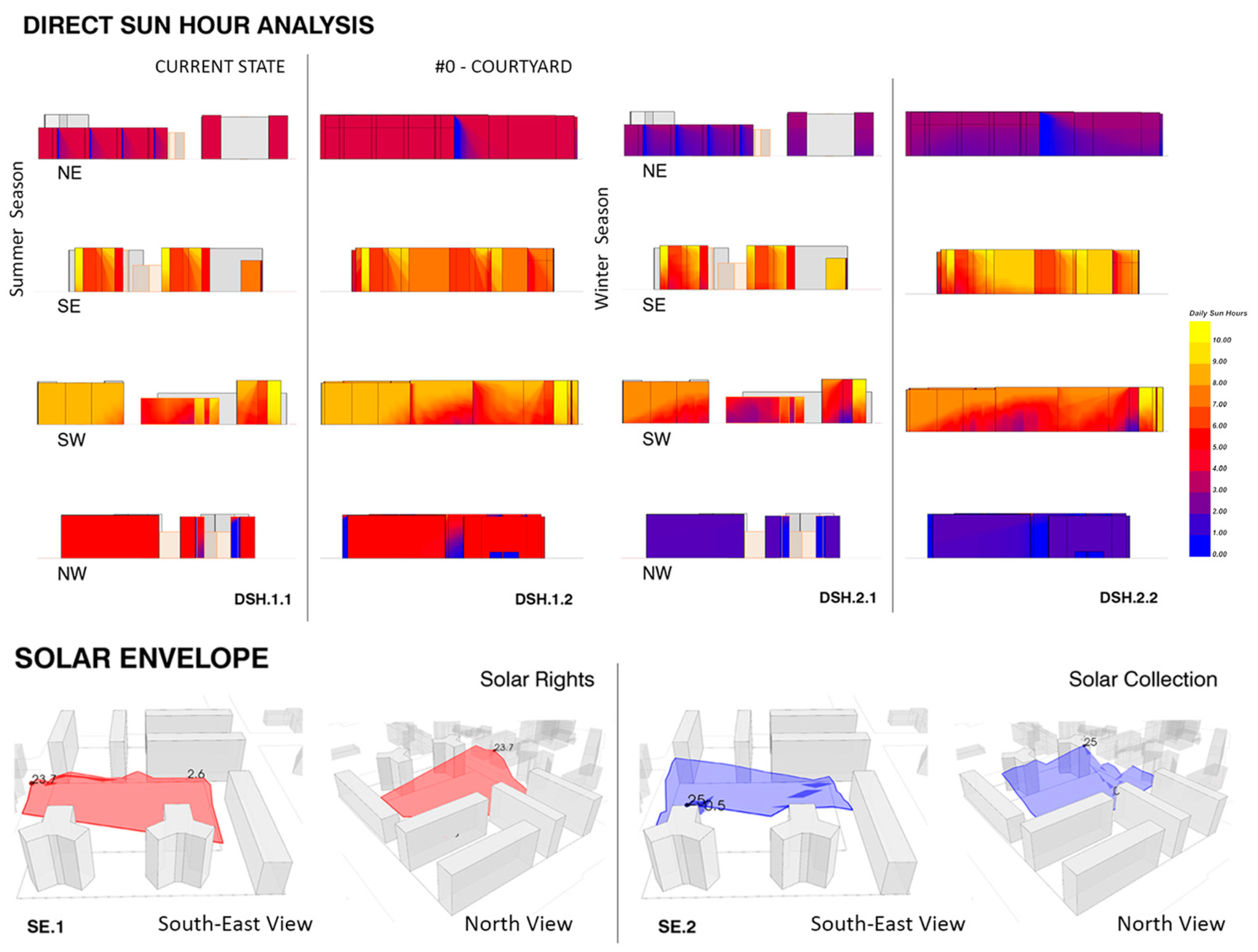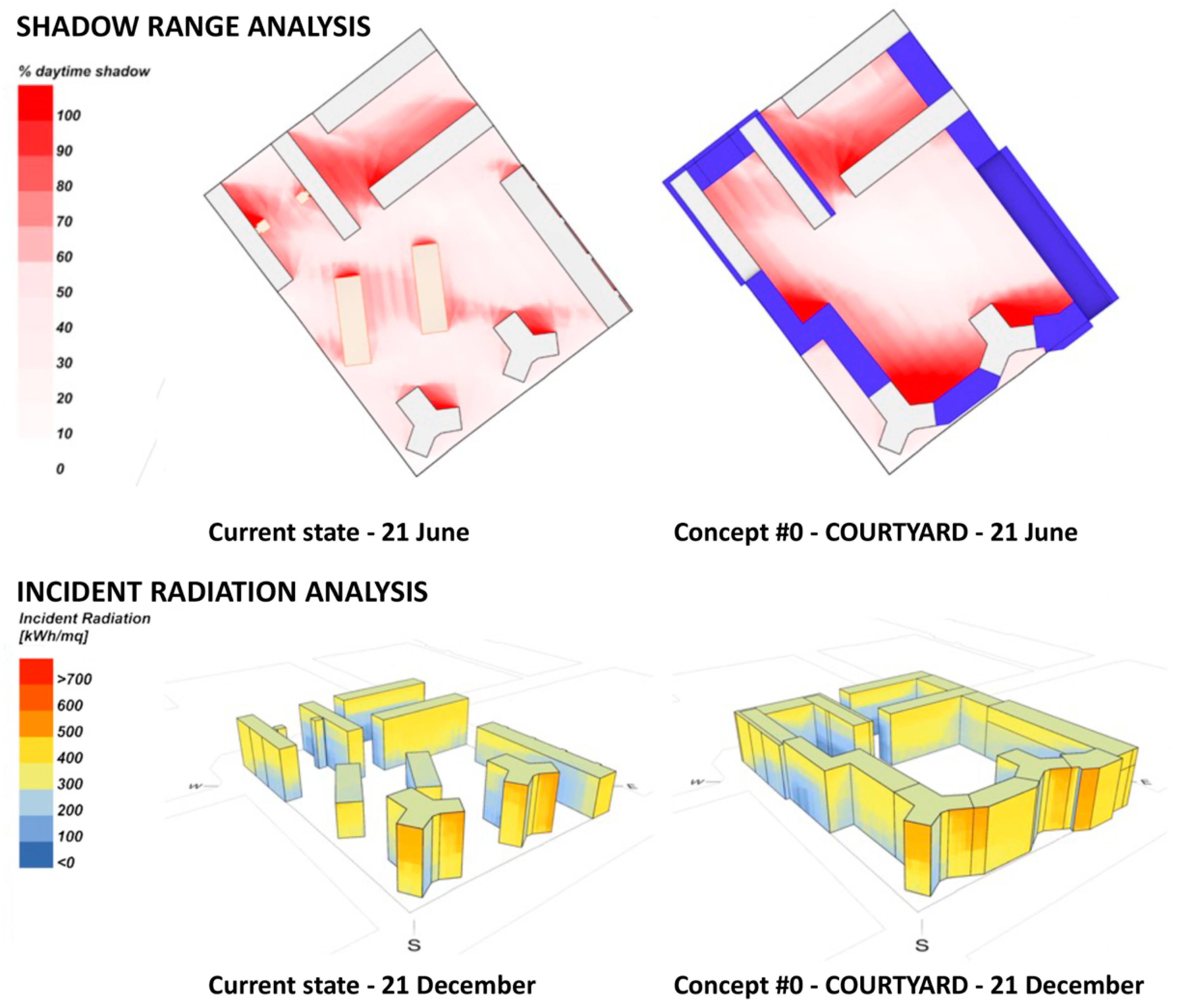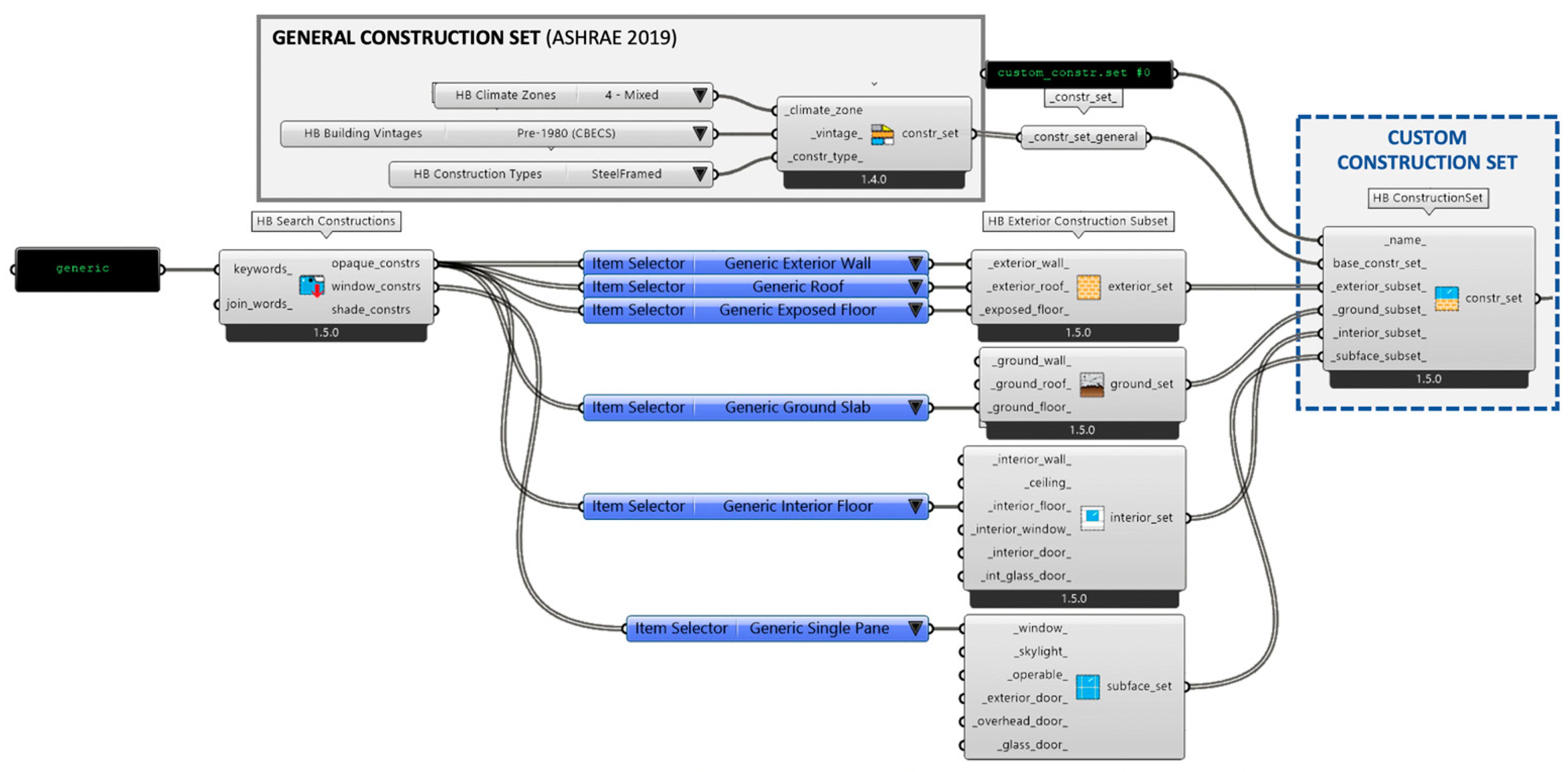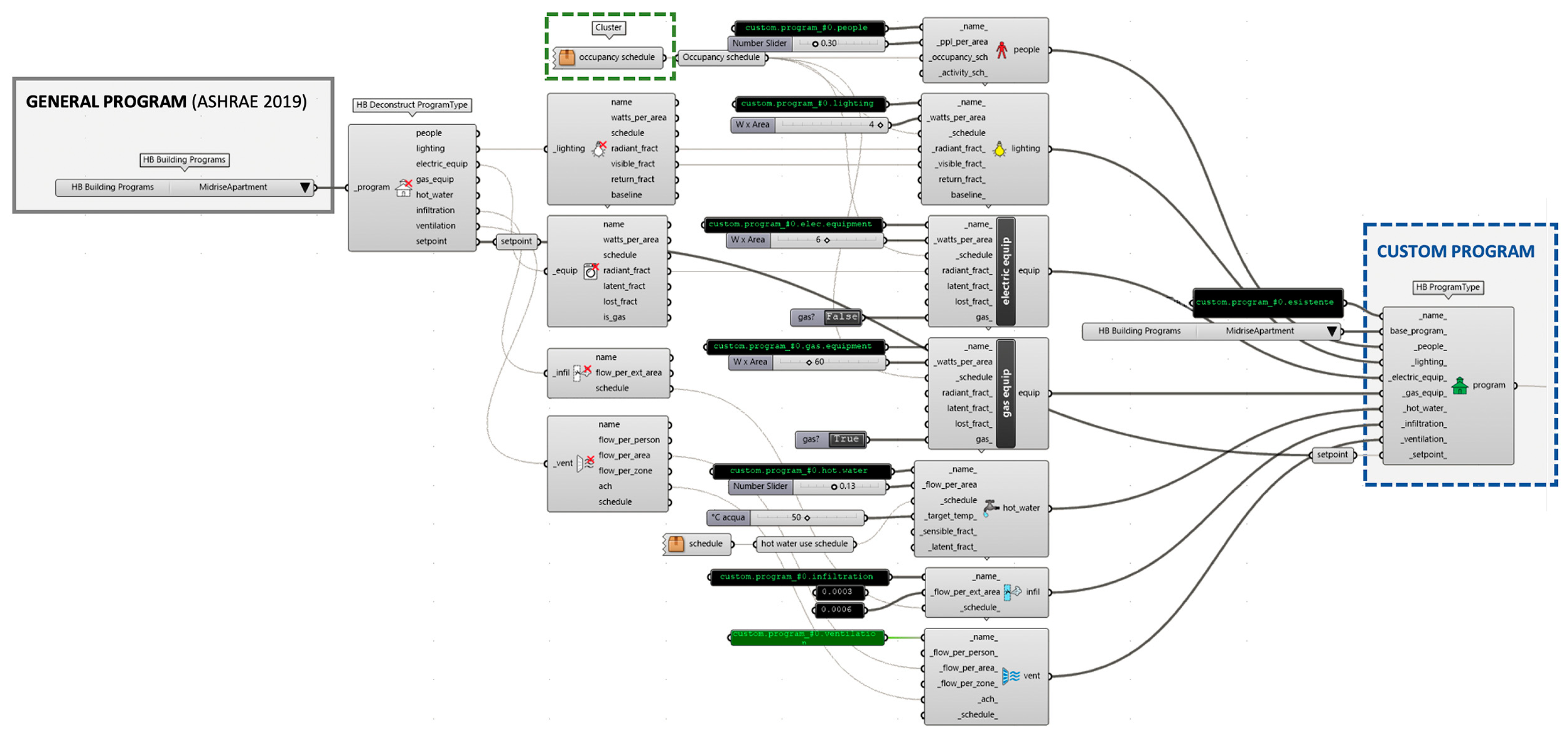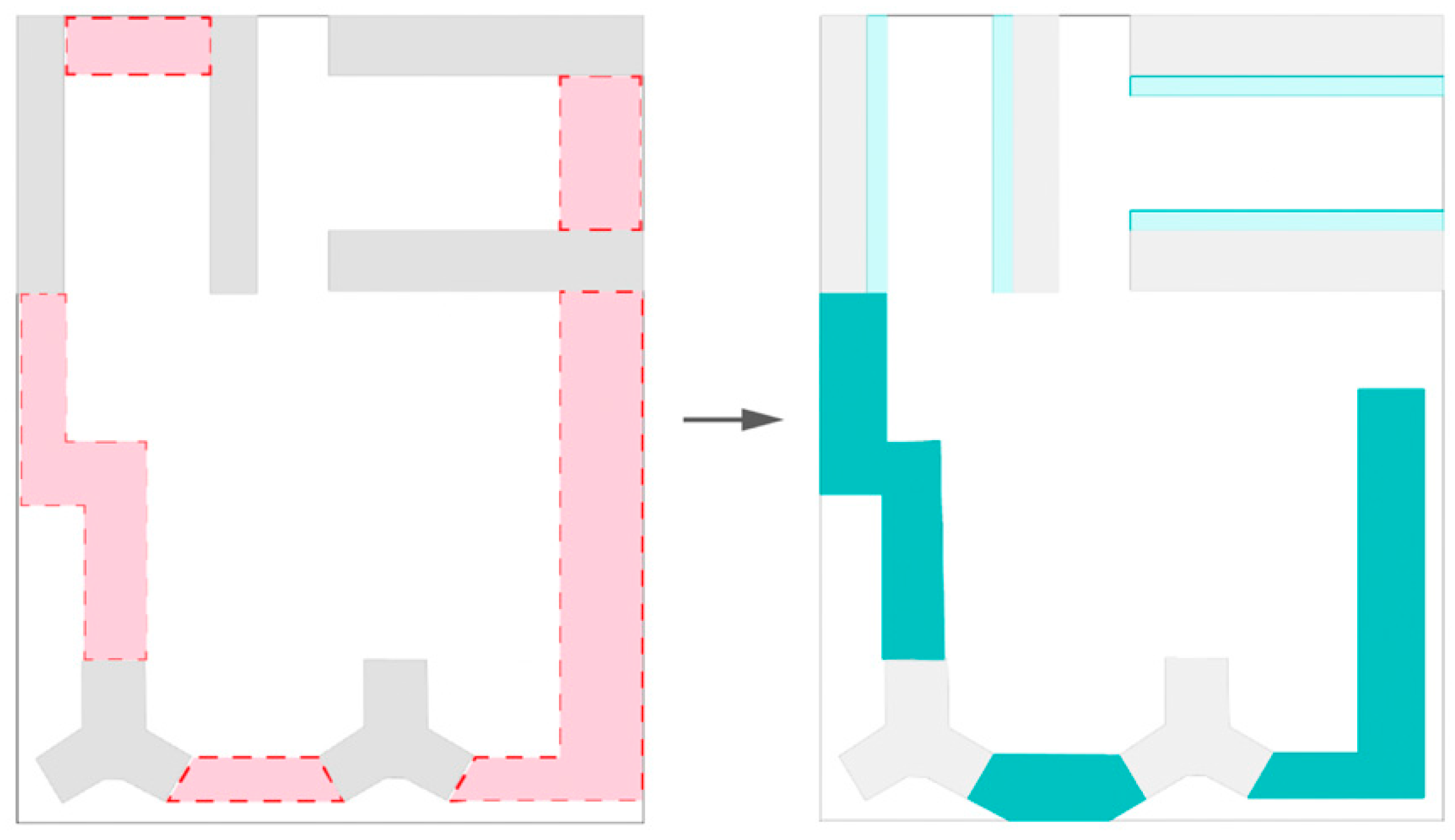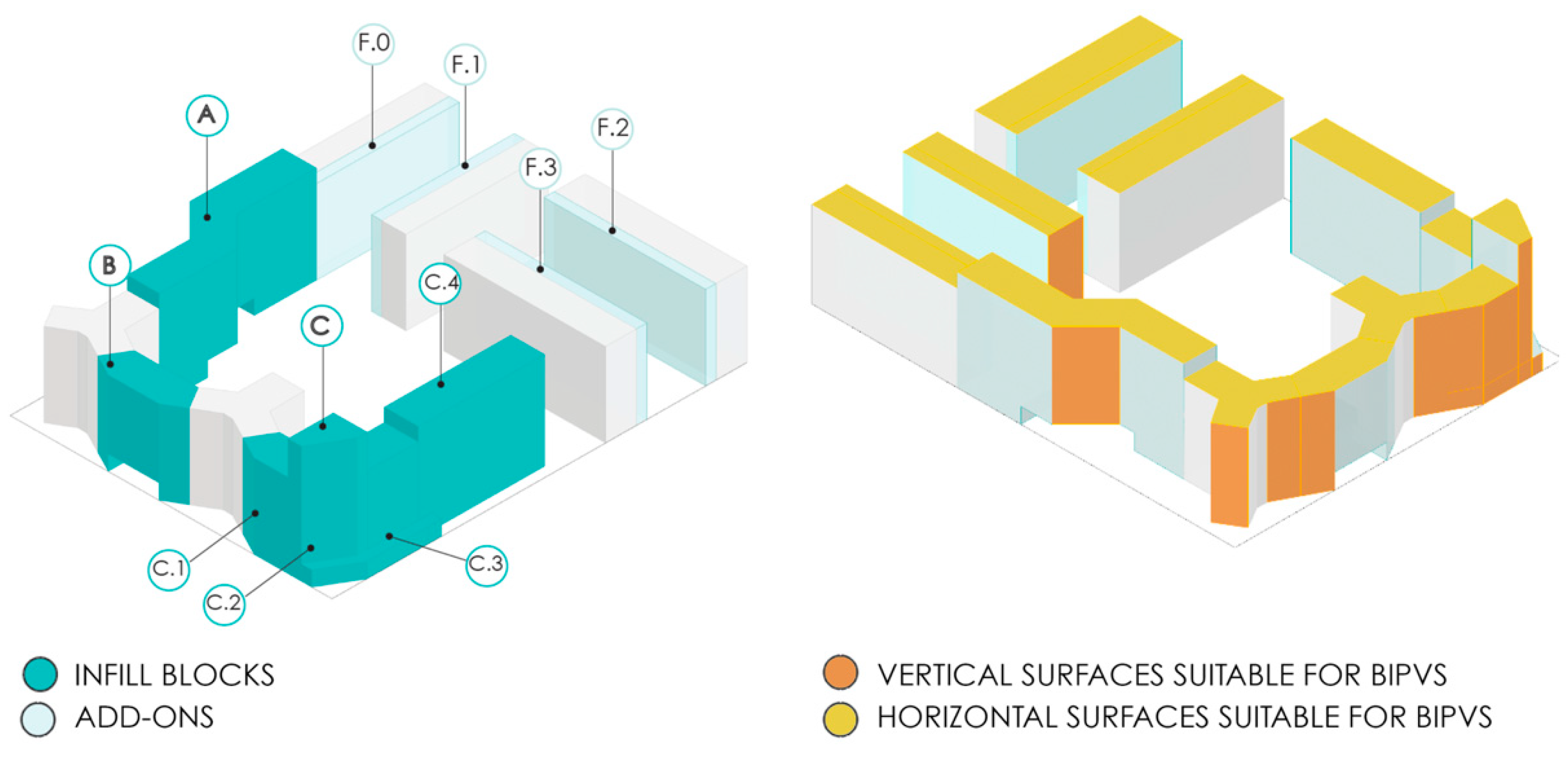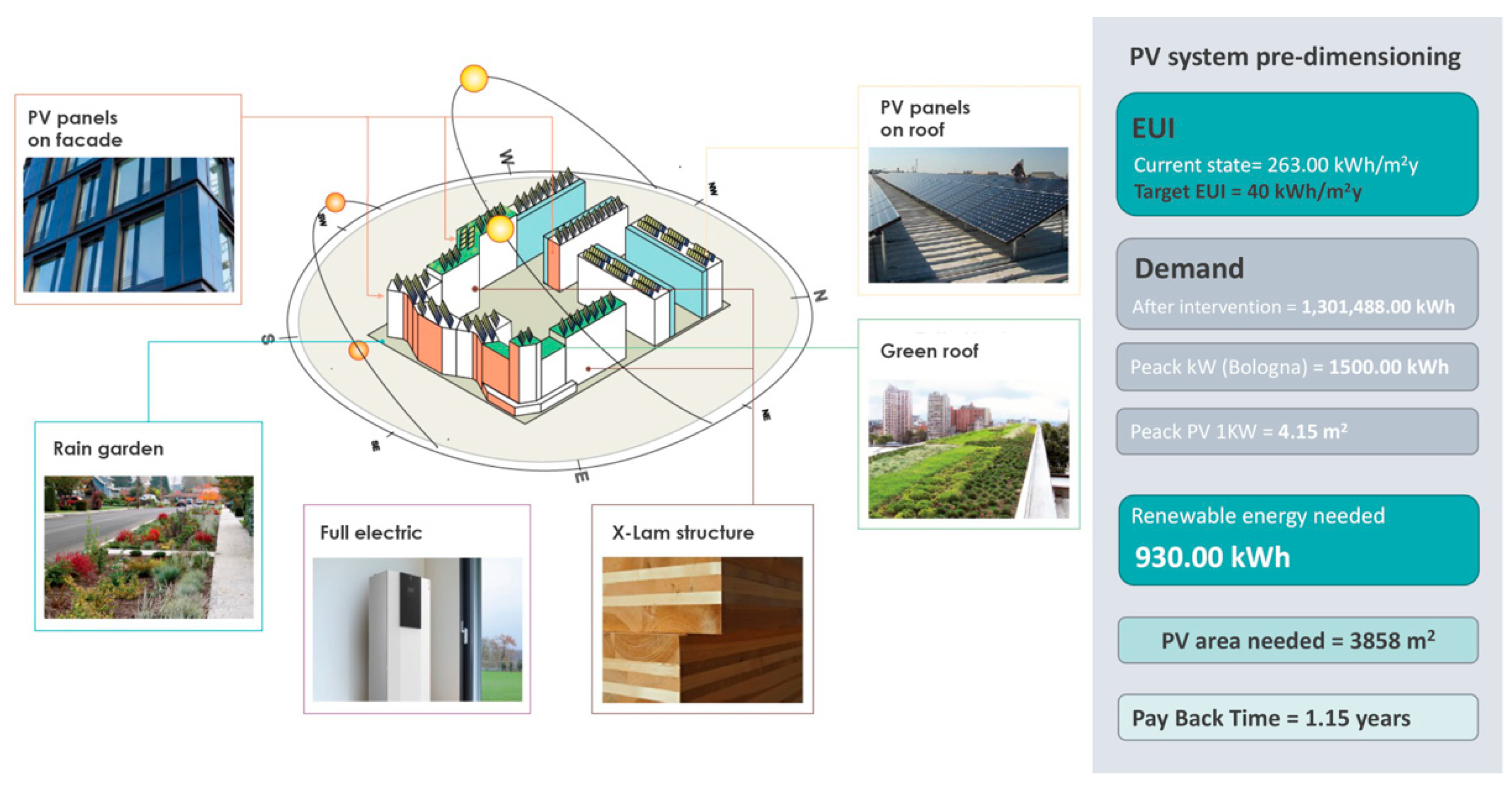1. Introduction
One of the most obvious phenomena manifested that can be seen in the medium- sized and large cities of our time is urban sprawl. The phenomenon of urban sprawl describes a certain peculiar settlement processes, that takes place mainly in the peripheral areas of consolidated urban cores. These processes are the result of a lack of foresight in spatial planning, which leads to high land consumption and considerable costs for society, both in environmental and economic social terms.
This formless urban growth, in other words periphery, peri-urban, agglomeration, urban fog, exurbia (i.e., diffuse city, in which the size of the city has exceeded the recognizable measure), as Ingersoll defines “urban sprawl”, occurs in the peripheral areas of cities, and combines uncontrolled urban expansion in these areas with the phenomenon of low population density [
1].
After the Second World War, the uncontrolled expansion of cities in Europe was initially curbed due to a new awareness of the historical building fabric damaged by the war, and consolidated but incisive spatially. At the same time, large housing estates were planned and built in the major cities. The European diffusion processes are of various kinds: economic, demographic, housing policy, and infrastructural. Nevertheless, two aspects can be assumed. Firstly, that agricultural areas on the outskirts of cities are subject to diffusion, due to their low cost, compared to already urbanized areas. Secondly, the decrease in the attractiveness of urban centres in contrast to the increase in the attractiveness of rural areas.
There is a clear need for the development of policies and strategies on land consumption and fragmentation of urban areas, that will lead to altered ecological balances, with less impact on local flora and fauna. Nevertheless, with the New Green Deal [
2], the European Union (EU) is carefully addressing issues of decarbonization, energy sustainability, and the use of renewable energy sources [
3,
4] through processes of urban regeneration, as well as the realization of new buildings. However, diffuse processes must be integrated into a legal framework that regulates them according to sustainable planning methods.
In European policy, the role of the city and the management of its resources are key elements for future sustainable growth. Urban regeneration is a coordinated set of actions not only for urban planning and construction, but also for the development of the social, productive, and cultural fabric of urban areas, with a view to environmental sustainability and strengthening the resilience of cities.
In terms of land use, agricultural use and open spaces should be minimized as much as possible. Nevertheless, there is a need for new housing units, but if land is withdrawn, it should be ensured that this can be compensated for elsewhere. For example, unused land could be recultivated or denaturalized so that it can once again provide the ecosystem services of unsealed soils [
5].
This process also introduces the principles of recycling and the circular economy, which are already expressed in the Europe 2020 strategy [
6], into urban and spatial planning, with the ultimate aim of decoupling urban development from the consumption of land resources [
7]. The concept of circular economy aims to transform current production and consumption patterns that place a significant burden on our planet and its environmental capacity [
8]. With the Communication Roadmap to a Resource-Efficient Europe [
5,
9], the European Commission (EC) has determined that European policies should take into account the direct and indirect impact of land use change by setting the ambitious goal of ‘zero net land take’ by 2050 [
5,
10]. Comprehensive interventions in buildings, in line with the objectives of the European directives, avoid further land use and can initiate urban and social regeneration processes towards future sustainable cities [
11].
Among the various instruments promoted for the regeneration of urban fabric is urban densification, which is seen as a process of selective intervention in pre-existing urban fabrics. These include different construction strategies, such as smart growth, the formation of communities of a manageable size, and the careful development of social needs. This positively influences the containment of the use of green spaces and the expansion of built-up areas at the expense of agricultural areas. A compact city with a high population density is the best answer to the need to accommodate growing population masses. Although Europe’s population growth is declining, other forces may be driving the growth in housing demand. One of the causes is the increase in smaller families, a phenomenon that can be attributed to various reasons, including changing lifestyles and an ageing population, which will keep demand for housing active. In addition, urbanisation is increasing significantly; 75% of Europeans already live in or near cities [
12].
The challenge for architects and urban planners is to develop strategies for the regulating the expansion of large urban agglomerations, considering land use and housing density.
3. Analysis of the Case Study
3.1. Research Methodology
This paper focuses on a specific building block located in the San Donato district in Bologna. The analysis employs a multi-criteria approach to identify socio-cultural obstacles, energy performance deficiencies, and economic barriers. These factors are crucial considerations for designing a comprehensive urban reshape and energy efficiency intervention at an urban scale. The multi-criteria approach, supported by specific digital tools, allowed us to balance all the above-mentioned factors and to select the most successful solution according to the project’s target, linked to local needs and regulations. These targets are social inclusion and accessibility, enhancement of green spaces, energy efficiency measures and RES installations, reduction of payback times and, hence, profit-making.
Based on the design concept of urban reshaping through infills and volumetric additions blocks, several intervention scenarios were proposed. The research method adopted pursued the following phases:
- (i)
Analysis of the architectural and social context, in order to identify the critical points in terms of accessibility to the block, connection with the road system, availability of green areas, presence of buildings with historical documentary value.
- (ii)
Creation of different intervention scenarios (Concept #0–COURTYARD, Concept #1, Concept #2, and Concept #3).
- (iii)
For each intervention scenario, a climatic and environmental analysis was conducted using digital simulations with the LadyBug–Grasshopper software. This was aimed at assessing the climate parameters necessary for determining potential blocks to be demolished, with the goal of enhancing the environmental characteristics of the blocks.
- (iv)
For each intervention scenario, an energy analysis was developed with Dragonfly–Grasshopper software. This was aimed at calculating the energy needs and consumption of different volumetric assumptions for urban infill interventions.
- (v)
Comparison of the different scenarios and selection of the optimal layout of buildings, balancing all the parameters calculated (for the climatic and environmental analysis: SunPath, Shadow Range, Universal Thermal Climate Index (UTCI), Direct Sun Hour Analysis, Incident Radiation, and Solar Envelope; for the energy analysis: End Use Intensity (EUI)).
- (vi)
Verification of the project targets in terms of profit from the investment before and after renovation.
- (vii)
Verification of the available surfaces for renewable energy sources (photovoltaic panels on roof and facade) to accomplish the energy balance of the whole settlement by and through the final reshaping of the urban blocks.
3.2. Multi-Scalar and Multi-Criteria Approach
As a first step, a multi-scalar analysis was carried out for all the aspects of the built environment at the urban scale, the block building scale, and at the level of the individual buildings. Given the multiple aspects to be considered in the energy and urban regeneration, the adopted approach has considered the evaluation of multiple criteria, based on the collection and analysis of data related to the environmental, energy and social characteristics of the site. From this perspective, the analysis aimed at “measuring to optimize” the urban context and the climatic context of the city in relation to the environmental characters of the blocks, through environmental analysis using parametric analysis software, as well as the performance aspects of the buildings, through district-scale energy analyses using parametric software.
Given the complexity of these criteria and the multiple indicators embedded in them, the multi-criteria analysis [
33] implemented here has necessarily been divided in different steps (see
Section 3.3,
Section 3.4,
Section 3.5), then analysed and compared to feed the next design steps in an optimized manner. This process has been designed to exploit more detailed parametric digital tools and explore various scenarios for an optimized deep renovation considering both volumes and related real estate values, as well as energy performance. In this framework, the optimized design solutions for the reshaped building blocks are those that provide the maximum increase in terms of real estate value while guaranteeing the energy balance and self-sufficiency.
3.3. Analysis of the Architectural and Social Context
The case study is an urban block in the San Donato district in Bologna, located in the Nort-East part of the city. San Donato is one of the city’s most diverse residential neighbourhoods, due to the age variability and the cultural backgrounds of the residents. This district stands as one of the city’s strategic points regarding vehicular mobility, as it has several major roadways and is served by metropolitan rail service (
Figure 1).
Nevertheless, one of the most significant concentrations of public housing exists in this district. Nearly 50% of the housing lacks adequate parking spaces. The area also experiences high population density, reaching up to 142 inhabitants per hectare, resulting in increased traffic, heightened demand for parking, elevated noise pollution, and a limited availability of communal facilities.
The green spaces in the San Donato district are primarily dedicated to agriculture. However, there is a recent trend of reclaiming areas for gardens and small parks within the closely woven grid of buildings near the historical centre (see
Figure 2). In general, while the amount of green space is considered insufficient, there has been significant redevelopment in recent years.
After a district-scale analysis, the study focused on the specific urban block located in the eastern part of the neighbourhood, closer to the city centre and to the railway.
The social perspective was registered by collecting advice from residents through ethnographic research and interviews. This information was crucial for understanding the residents’ needs and, thus, supporting the decision-making process in terms of selection of buildings to be demolished (such as buildings 8 and 9, that were indicated as inadequate for spatial characteristics, functionalities, and indoor comfort levels from residents).
The urban block takes on a rectangular configuration and comprises a total of nine buildings, as illustrated in
Figure 3. Seven of these buildings align in a row. The structures include: two “Popolari” blocks (blocks 1 and 2); two “Popolarissime” blocks (blocks 3 and 4); two buildings of lower height than the others, oriented at an incline to the street axes (blocks 8 and 9, proposed for demolition both for the ethnographic analysis and for their negative climatic impact due to the undesired projection of shadows within the courtyard and towards the existing buildings); two tower buildings with a distinctive “Y”-shaped structure (blocks 6 and 7); and a single in-line building (block 5) (
Figure 4).
The urban block is bisected by a private driveway, featuring a limited number of condominium parking spaces. This roadway, along with a handful of parking spaces within the inner courtyards, defines the internal pathways, which are degraded and poorly interconnected due to the enclosure of the outdoor spaces of the tower condominiums.
The block is bounded to the west by a one-way street and to the east by major high-traffic streets. Immediately next to the lot is the Parker-Lennon garden which, however, does not appear to have pedestrian connection with the block.
The construction of the parcel is part of a plan of social housing interventions in the first half of the 20th century, aimed at the weakest classes of the population, with reference to the families of recent immigration in the early post-war period.
The first buildings were constructed in the immediate first post-war period: among them are the “Popolarissime”, designed between 1934–1936, and the “Popolari”, whose name derived from their social housing function (in Italian, “popolare” alludes to the working class for whom these buildings were built). All these buildings were constructed as an emergency plan by social housing institutions to provide housing for families evicted from the historic centre districts demolished during the fascist era. They are buildings with a reinforced concrete frame structure and brick envelope. The current thermal and structural performance of these buildings is very poor and, therefore, deep renovation interventions to improve performance and to modify some distributional characteristics of the interior spaces are necessary to improve living comfort. The entire built-up area of the block, although it emerged in successive phases over a twenty-year period, shows a clear rationalist imprint regarding its architectural style. Rationalism imparts a design approach characterized by rows of buildings aligned perpendicular to the streets, featuring a uniform orientation. The structures are evenly spaced at a minimum distance to prevent shading between buildings, ensuring that facades receive ample sunlight, even during the winter solstice.
From the naturalistic point of view, the subdivision is characterized by various types of trees, including tall trees (common plane, Atlas cedar, oak, and beech), which provide excellent shading, protection against solar radiation, and low maintenance costs given their performance.
Today, such building stock, built more than fifty years ago, is inadequate with respect to current energy and seismic safety requirements and regulations, and therefore requires consolidation and energy efficiency interventions. Furthermore, considering demographic indicators, there is a necessity for interventions aimed at enhancing accessibility and eliminating architectural barriers within the residential infrastructure.
The energy simulations were developed through the use of digital parametric tools, namely
Dragonfly–Grasshopper, which uses the simulation platform
URBANopt SDK (Urban Renewable Building And Neighborhood optimization) 0.10.0, based on
EnergyPlus 23.2.0 and
OpenStudio 3.7.0 SDK, aimed at district-scale thermal and electrical analysis for energy modelling of urban communities and districts. The results from these energy simulations prove the significant deviation of the buildings from the energy requirements standards of a nZEB, mostly due to high insulation deficits in the envelopes and oldness of energy installations accompanied by visible degradation of materials. These characteristics are combined with the complexity of the buildings due to the varying orientations, heights, the almost total absence of adequate interior lighting and a parallel deficient passive shading. In general, the transparent elements of a building play a key role in the heat and mass transfer control, and also in natural light penetration, sound insulation, the thermal and visual comfort of the occupants and their health, and the improvement of aesthetic features [
34]. Therefore, the bioclimatic design of this urban block emerges as a particularly challenging project, which the present research endeavours to address. This includes the incorporation of volumetric additions while mitigating potential adverse impacts.
3.4. Climatic and Environmental Analysis
According to the Köppen–Geiger classification, the climate of the city of Bologna falls into the “Warm summer temperate climate” range, typical of the low-altitude areas of northern Italy. In the cool season, temperatures range from 0 °C to 22 °C. The mild seasons range from 8 °C to 25 °C, and during them, about 60% of the daytime hours require no air conditioning. For this reason, passive strategies of ventilation, lighting, and reduction of solar loads in indoor spaces were incorporated in the development of this project. Throughout the summer season, the temperature ranges from 16 °C to 36 °C, with daytime temperatures mostly surpassing 25 °C and experiencing high solar radiation levels. Hence, it is imperative to implement effective external shading in the project, strategically designed to reduce solar exposure on glazed facades and alleviate the workload on air conditioning systems. Examination of climatic data for the Bologna area indicates a robust average of daily sunshine hours, exceeding 12.2; however, this can vary based on the prevalence of cloudy days. The incorporation of site-specific climatic data, combined with a thorough contextual analysis, has proven essential in identifying the optimal environmental and climatic conditions for conducting climate simulations.
All simulations were carried out through the LadyBug plug-in of Grasshopper software, a parametric workspace within Rhinoceros 8, where the geometries then subject to the simulations are modelled. Ladybug provides a variety of interactive 2D and 3D climate graphics that support decision making during the early design stages through solar radiation studies, view analysis, and modelling of sunlight hours.
The fundamental concept guiding the design process revolves around the aspiration to establish a unified and expansive urban courtyard that mirrors the dimensions of a private block. This courtyard aims to be easily accessible to residents, incorporating green spaces and communal facilities. As a result, initial design decisions dictated the removal of centrally positioned blocks (blocks 8–9) arranged diagonally in relation to street directions. This choice was driven by the blocks’ varying heights and orientations compared to surrounding structures, introducing environmental challenges that make bioclimatic design notably complex and hindering the creation of a usable outdoor area. Additionally, it was deemed necessary to demolish the stairwells of blocks 1–2 (
Figure 5) due to their structural inadequacy, as they were constructed later than the buildings themselves. This decision contributes to a proposed demolition area totalling 593 m
2.
Due to the parametric process, it was possible to carry out the simulations on different input geometries by considering not only the existing state of the site, but also assumptions of demolitions and new infill volumes. These were useful to map and compare different morphologies of the block. Specifically, the solar path was initially analysed through the SunPath parameter analysis during the summer season and in two different hours (10 am and 3 pm). Furthermore, the Universal Thermal Climate Index (UTCI) was assessed in terms of Temperature UTCI (measured in perceived temperature in °C) and Comfort UTCI (measured in UTCI thermal stress); this allowed us to obtain insights into the interior microclimate of the urban block and define strategies for open spaces (
Figure 6). Other parameters linked to the solar impact on the buildings have been assessed, such as the Shadow Range in summer and winter season and the yearly load (measured in percentage of daytime shadow) (
Figure 7). Subsequently, the analysis of the Incident Radiation (measured in kWh/m
2) was carried out on the facades of the volumes in summer and winter season (
Figure 8), as well as the Direct Sun Hour analysis during summer in order to calculate the daily sun hours on the envelope of buildings (
Figure 9). Through the analysis of all these parameters, combined also with the Solar Envelope study (
Figure 9), it was possible to understand the spatial relationships between the buildings and to locate the surfaces with higher and lower illuminance criticality.
All the results obtained in the simulations were then collected in a comparison table and each heatmaps displayed in a general abacus of the environmental simulations (
Figure 6,
Figure 7,
Figure 8 and
Figure 9).
Among the various values mapped, it is of particular interest for considerations on photovoltaic (PV) systems, the share of solar irradiance that invests the facades of the south front of the block: in fact, in the winter season, this value reaches higher peaks than in the roof. In addition, the presence of a full elevation on the south front would allow a significant gain of shading in the inner courtyard (+12%) by defining clearer areas of shade and light and, therefore, be more easily modulated by design (
Figure 10).
In the local area, a PV system that is in the optimal tilt (35°) and climatic conditions can produce, for example, around 1200–1300 kWh per year per kWp of power while, when opting for flat PV, it is reduced to 1000–1050 kWh per year per kWp of power.
In particular, the Direct Sun Hour analysis and Incident Radiation analysis climate simulations provided useful data for the positioning and quantification of the PV systems envisioned as the main strategy of ABRACADABRA for self-supply of energy, as well as important indications on the most appropriate buildings to host on top Add-ons.
Roofs turn out to be the surfaces that receive the most solar radiation (in summer) with seasonal peak above 600 kWh/m2, thus are the most suitable for the installation of PV systems. Among the vertical surfaces, on the other hand, the south-facing facades are the most suitable for PV installation; in particular, the south front of the lot (5-6-7-D-E), which includes two blind facades, exceeds the values in the roofing in winter. In addition, passive shading systems have been provided on the south-east, south, and south-west fronts.
3.5. Energy Analysis at the District Scale
The analysis phase was conducted via district-scale energy simulations carried out by Dragonfly, a plug-in of Grasshopper software, which, through the simulation platform URBANopt, allows the calculation of the energy use of an urban district energy model. These analyses made it possible to parametrically quantify the physical quantities of the geometries processed in the mentioned model, and especially to evaluate and estimate the energy needs and consumption of different volumetric assumptions for urban infill interventions.
In particular, the value of EUI, which is an energy efficiency indicator used in building design and/or construction, mainly used in the United States, was mapped in the different simulations to estimate the energy balance of the geometric models being simulated. The impacts of consumption for heating, cooling and lighting systems were analysed, representing the Monthly EUI and Monthly Energy Balance values (measured in kWh/m2 for energy intensity).
Calculation of heat demand was carried out based on a heat balance of the environment bounded by the building envelope. Knowing the efficiencies of the plant systems, the primary energy demand can be traced from the EUI value. To evaluate the results of the energy analyses, the values of EUI and more generally of energy consumption provided by the New Building Institute (NBI) [
35] were taken into consideration. This provides average consumption targets for different types of building use, dividing them according to their climate class. In addition, NBI sets EUI standards for achieving nZEB. In this case, for the residential typology connoted as “Mid-rise Apartment” by ASHRAE programs (i.e., multi-family residential building higher than five stories), the achievement of the nZEB target occurs for an EUI of less than 75 kWh/m
2year. This value was considered as a numerical reference value for the comparison between the simulated design scenarios.
A precise “Construction set” was created within the
Dragonfly algorithm to describe the architectural elements of the buildings and detail the energy model within the simulation algorithm. Each set contains the stratigraphy of the materials used, each characterized by its respective mechanical and physical properties (
Figure 11).
For the “Construction sets” referring to the current state, the construction stratigraphies of the buildings in the block was considered. In particular, the following traditional stratigraphies of residential construction built in Italy in the 1930s–1970s were evaluated: non-insulated facades in bricks (with a thermal transmittance U of 2.213 W/m2K), hollow-core concrete roofs and ground-floors, and single-glazed windows.
Instead, stratigraphies referring to the deep renovation intervention mainly aimed at the energy refurbishment of the building envelope were associated with the energy simulations carried out on the assumptions of new volumes in the block. In particular, for the deep renovation of existing buildings, the following solutions were considered: the implementation of an External Thermal Insulation Composite System (ETICS) in rock wool (12 cm thick) for external walls, the integration of a thermal insulation layers in recycled textile fibres for roofs, and double/triple-glazed windows. For the new infill blocks, the envelope is considered as a ventilated facade composed of a X-Lam structure, high thermal insulation layer in rock wool and wood fibre (14 cm thick), a light metallic sub-structure for the creation of a micro-ventilated airspace (3 cm thick), and a dry finishing cladding system in ceramic (1 cm thick). The thermal transmittance of the envelope systems considered for these scenarios ranges from 0.250 W/m2K for the renovated facades to 0.120 W/m2K for the more performant new facades.
The “Construction set” uses indicative parameters that refer to average values of high-performance, but still renovation technological solutions; the envelope performance that was considered for new construction has higher performance. All the selected stratigraphies meet the minimum requirements established by the Minimum Environmental Criteria (CAM), introduced in Italy by Law No. 221 of 2015 [
36].
Furthermore,
Dragonfly needed the setting of precise “Programs”, which are data sets describing the intended uses, the times of use of the buildings and the consumption of the main systems (
Figure 12). Specifically, for the simulations carried out, two personalized programs were created which refer to the state of the existing building (“Program-Current State”) and that of the deeply renovated building (“Program-Deep renovation”). Both programs start from the default program proposed for buildings intended for residential use characterized as Mid-rise Apartment by the ASHRAE programs, which then differ in the values of the parameters regarding electricity and gas consumption, losses due to thermal bridges, and the categories of HVAC systems.
Table 1 reports the values considered for the two programs, defined according to standardized values reported in literature for traditional built heritage [
37] used to carry out the energy simulations, whose results are shown in
Figure 13.
For all the intervention scenarios analysed (Concept #0–COURTYARD, Concept #1, Concept #2, and Concept #3), the same “Program-Deep renovation” and the same “Construction set-Deep renovation” were used; indeed, they differ only in their geometry.
The comparison between the existing urban block and the different intervention scenarios (
Figure 13) allowed us to assess the impact of possible energy upgrading strategies on the consumption of the current state. Although the variation in EUI value is minimal, the analyses show that, by using the same “Program” and “Construction set” for all the intervention scenarios, the more compact shape of the volumes leads to an improvement in the overall energy requirements. In conclusion, the Concept #0–COURTYARD scenario is the most efficient, with an EUI value of 123.90 kWh/m
2.
The comparison of the results shows that a significant reduction in building energy consumption is possible, mainly due to two factors. First, through retrofit of the building envelopes of the existing blocks to solve the lack of insulation in the infills. Second, through the infill and increased volume interventions which, by creating a “compact” morphological arrangement, significantly reduces the overall energy demand (EUI). That overall energy demand is, in its average values, always more than halved compared to the EUI of the current state of 263 kWh/m2 year.
4. Urban Re-Design Project
4.1. Definition of the Project Targets
After the context analyses were concluded, a meta-design approach was initially adopted on the case study, in which the strategic and theoretical guidelines for sustainable urban densification were resumed. Thanks to the parametric tools used, the architectural and energy design objectives were monitored throughout the concept phase, with the intention of optimizing the design proposals, which were then detailed from a technological and systems point of view.
To manage the meta-design phase, the objectives of economic attractiveness of the intervention and energy self-sufficiency were defined through project targets. These were used as numerical indicators to quantitatively assess and compare the performance of different design scenarios. In fact, through the parameterization of the physical and performance characteristics of the new project volumes, it was possible to calculate in progress the relevant values concerning the set targets.
Specifically, two project targets were identified:
The first one is related to the profit from the investment, focusing on the economic feasibility of the intervention and the attractiveness for investors.
The second target focuses on the use of renewable energy sources, by sizing the PV area for energy self-sufficiency, monitoring the energy savings and finally quantifying the payback time of the investment.
Regarding the profit of the investment, ABRACADABRA has shown that the implementation of measures to increase urban density, through the volumetric expansion, helps to economically support the renovation of the entire building through the income generated. This contribution has an effect also at the urban scale, proposing a densification of the built environment through urban infill interventions. This can be particularly attractive, both for investors interested in new spaces, but also for the residents who can gain from the energy savings, the space addition and the increase in the commercial value of their property. Regarding the costs per m
2, data was taken from the
Prezzario della Regione Emilia-Romagna of 2022 [
38] and from the ABRACADABRA project database for each type of intervention. In addition, the gains obtained by the resale of nZEB buildings were considered through local market research for the area under study. A target return on investment was set, corresponding to profit over total investment set at a minimum of 15%.
4.2. Design Project Choices
The starting point of the design was the energy performance and bioclimatic potential derived from the comparison of the results between the current state and the Concept #0–COURTYARD hypothesis. The project was dedicated to achieving a condensed configuration for the new subdivision, aiming to facilitate the development of internal courtyards accessible to residents. To fulfil this objective, as mentioned in
Section 3.2, the proposal involves the demolition of specific structures within the urban block. The identified elements for demolition include: the external stairwells of buildings 1 and 2, characterized by non-compliance as they were constructed later and did not meet standards; and the removal buildings 8 and 9, which is motivated by their unfavourable orientation and height, posing bioclimatic challenges and acting as an impediment to the establishment of usable outdoor areas (see
Figure 5).
With respect to the Concept #0–COURTYARD hypothesis, the idea of implementing infill blocks to connect the existing pairs of buildings 1–2 and 3–4 was excluded. Buildings 1–2 are subject to historic preservation constraints. On the other hand, the intervention in buildings 3–4 would be too invasive for the related interior spaces, also negatively affecting the natural lighting levels.
Nonetheless, the numerous blind facades have strong potentials for infill intervention. Three new volumes (A, B, C) were considered useful to connect buildings 1, 7, and 6, as well as a new building contiguous to block 6 that would architecturally reset the facade of building 5 subject to demolition and allow its lost spaces to be recovered (
Figure 14). Other volumetric increases have been planned as facade Add-ons, integrating an exoskeleton on the interior facades of buildings 1, 2, 3, and 4, to recover their vertical connections and to provide new spaces for residents in the form of balconies, verandas, and galleries. In any case, deep renovation is planned for all existing buildings that are not subject to demolition with the intention of reaching the nZEB target and improving their envelopes and systems.
For this first design scenario, indicators of profit and payback time of the investment were calculated in a preliminary manner. These preliminary results (see
Table 2 and
Table 3) showed that the profit was very low: the considered average selling price per m
2 of about EUR 4100 has been multiplied by the total area increase of 5576 m
2 for a total profit of EUR 1,191,682, corresponding to an investment return rate of 5.49%.
Therefore, from the volumes considered, which were totally filled from ground to sky, the general morphology of the blocks was modified, in terms of height and plan shape of blocks A, B, and C (
Figure 15). The infill buildings, named A, B, C, were shaped with the aim to increase the residential floor area by adding additional levels, especially at the corner building C. In addition, ground-floor openings were created in blocks A and B to facilitate access to the courtyard. The new volumes allowed for improved energy performance to come closer to the targets set (
Table 2).
Each of block A, B, and C was analysed individually through the use of Ladybug. Climate simulations were conducted to assess shading and incident radiation for the inner courtyard and critical facades in the block. The project targets on the new lot setting were then re-evaluated in order to further lower the benchmark pEUI for nZEBs (equal to 75 kWh/m2year, as indicated by NBI). The final design project includes a higher ratio of m2 of built-up area, which directly affects the profit generated from the resale of space: thus, it is guaranteed to exceed the minimum threshold of 15% set at the beginning of the project.
Regarding the dimensioning of the required PV area, incident radiation analyses have allowed for the more precise definition of the average peak radiation data for Bologna, resulting in a lowering of the required PV area, to be added to the surface area of the most favourable facades in terms of solar exposure, resulting in a total amount of 3858 m
2 of PV surface. The results on payback times are also positive, resulting in 1.15 years, due to the increase of 10% of the commercial area and of the sale profit of the new volumes. The target is thus achieved. Overall, in comparison with the current state of the district block, this proposed retrofit scenario will lead to a reduction of 75% of the total energy demand, now amounting to 1,301,488 kWh, and an energy savings of 223 kWh/m
2y (
Table 3).
The analyses carried out, together with current regulations, supported the selection of the specific solutions needed to achieve energy efficiency goals. Among the solutions studied, the following aspects were investigated in depth: structural technology, thermal and acoustic insulation, on-site energy supply, and reuse of energy through facilities that can fully meet the building’s overall needs.
Regarding the energy aspects of the concept, it was possible to reassess and lower the estimated
pEUI (from 75 kWh/m
2y to 40 kWh/m
2y) thanks the minimal energy consumption provided by extremely high performant solutions for the envelope (X-Lam panels and additional thickness of thermal insulating materials) (
Figure 16). In particular, the following solutions were identified:
Use of XLAM panels for the structural system and external envelope, chosen for its significant energy, static and environmental advantages.
Installation of a PV system on roof and facade, sized to ensure the storage and supply of sufficient renewable energy for the autonomy of the new housing settlement.
Implementation of a condominium thermal power plant system with heat pumps to supply the cooling, refrigeration and domestic hot water systems.
Use of extensive green roofs on the roof for water recovery and beneficial effects in terms of reducing the heat island effect of the urban block and evapotranspiration for the large PV plant on the roof.
The main objective concerns the elimination of gas-fuelled plants to prefer the use of full-electric, in line with European directives to reduce CO2 waste.
5. Conclusions
This paper seeks to illustrate the potential strategies for urban densification, employing a sustainable, and economically viable approach. It aligns with the successful model presented by the ABRACADABRA research project, extending its application to a larger scale of intervention beyond individual buildings. The practical efforts undertaken primarily concentrated on achieving energy self-sufficiency for an entire block of buildings located in San Donato district in Bologna. Maximizing economic gains through income generated by new construction, aimed at deep architectural and energy transformation.
The chosen block, identified for densification to create a zero-energy subdivision, possesses several advantageous qualities that align with the pursued strategies for urban infill. This implementation unfolded practically through a meta-design phase, wherein data collected during a multi-fold analysis played a crucial role in calibrating the entity of for the urban infill interventions and energy retrofit actions. This involved establishing numerical project targets that encapsulated the goals of substantial economic gain and a notable enhancement in energy performance of the area (reduction of 75% of the total energy demand, reaching beyond the EU and local regulation standards). Throughout the process, these project targets were continuously monitored and updated. The objective was to craft a design that effectively responded to the urban-scale strategies explored in this contribution, ensuring a harmonious integration of the densification and energy retrofit efforts. The proposed analysis and design method, with the use of parametric software to monitor performance requirements, can be replicated and applied to other similar urban contexts, allowing the test and validation of densification strategies. Although limited to a specific case study, the proposed design solutions demonstrate the technical and economic feasibility of urban regeneration aimed at implementing PEDs that might result in both attractive and profitable interventions for the environment, investors, and residents themselves.
The successful attainment of project target through this strategy underscores the effectiveness of interventions based on the combination of Add-ons and urban infill to enhance urban consolidated settlements, while avoiding further land consumption. Simultaneously, the commitment to deep renovation to align with current energy transformation objectives for existing stock contributes significantly to the broader European agenda. This collective effort aims to achieve climate-neutral cities in Europe by 2050, emphasizing the dual benefits of intensifying urban areas while meeting critical energy efficiency goals at both the local and continental levels.
The limitations of this densification strategy concern the possibility of adopting it only for non-historical building heritage, which is not protected by regulations in terms of reshape and deep renovation of the existing environment. Given the complexity and multiplicity of the criteria to be considered for achieving an optimized design solution, the proposed methodology is based on a multi-scalar and multi-criteria analysis, divided into different steps, supported by parametric digital tools. Further research development could consider the possibility of controlling the design process through the use of holistic digital platform combining and balancing all design criteria and solutions.
